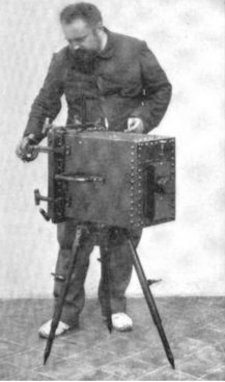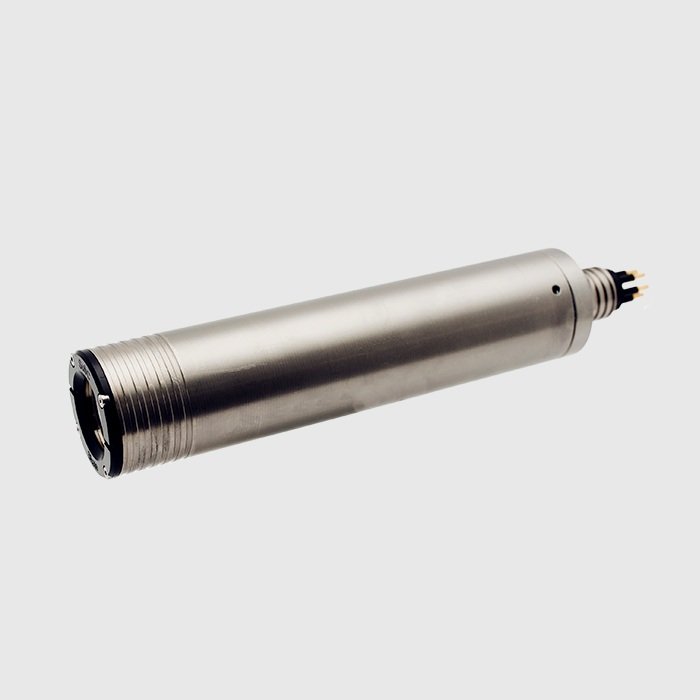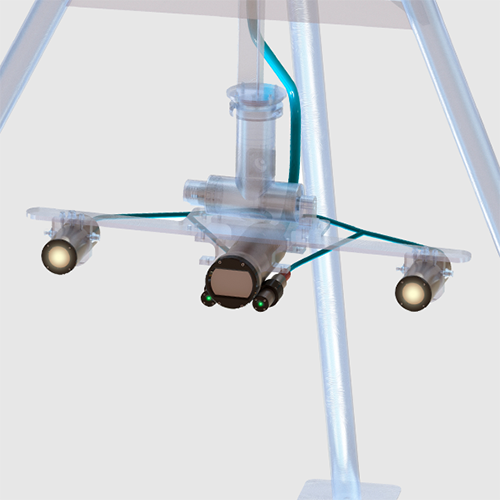Advancements in Subsea Optics and Imaging
Learn about the developments in subsea imaging and subsea optics technology that are driving growth in ocean discovery, inspection, and conservation.
Subsea imaging has been practiced for nearly 170 years. In 1856, William Thompson, a solicitor with a keen interest in marine life, designed a camera system that could capture underwater scenes. Using a metal and glass box mounted to a makeshift tripod, Thompson captured the first known subsea photo. It was 18 feet below the surface of Weymouth Bay on the south coast of England.
While the resulting image is not exactly a high-definition shot worthy of the cover of National Geographic, it is a defining moment in ocean exploration. Since that day in 1856, subsea imaging technology has made great advancements, allowing us to see the aquatic world in ways that people like William Thompson could only imagine.
The first underwater photograph was taken on a wet collodion plate in 1856 by William Thompson.
What is Subsea Imaging and Why is it Essential for Ocean Exploration?
As a global society, we have a long history of ocean exploration and, as evidenced by the quality of historic images, early subsea imaging and subsea optic technology left much to be desired. Unsatisfied with what would be learned from the surface and from images that offered little detail or insight, technologies have evolved to help us understand and learn about the aquatic environment. Early technologies required a lot of trial and error, and the results were often dark and blurry. Underwater imaging technology didn’t truly take off until a pair of French brothers, Louis and Auguste Boutan, developed underwater camera technology that produced clear images and was reliable.
Taken sometime around 1899 by Louis Marie-Auguste Boutan in the South of France, the image depicts his Romanian colleague, oceanographer and biologist, Emil Racovitza, holding up a sign that in French means “Underwater Photography”.
Throughout the early 20th century, subsea imaging technology continued to evolve. In 1923, underwater cameras were able to capture colour images, and by 1940, the technology had evolved to allow for underwater video capture to occur. The introduction of underwater video technology ushered in a new era of ocean exploration.
Louis Marie Auguste Boutan and the underwater camera that he invented in 1893.
Modern subsea cameras have come a long way since the first models. They can often take both stills and videos.
With 71% of our planet covered by water, and only a small fraction of that having been explored, the introduction of subsea video technology created new opportunities in ocean research. Marine archeology was now possible. Researchers could explore a wreck or site of significance without disturbing the area. Marine zoologists could now bring their findings to the surface. Subsea imaging technology provides a non-invasive way for researchers to study the aquatic environment. Because of these technologies, researchers have been able to uncover pieces of our history, once thought lost to the ocean floor. We are able to see, and experience, how marine species interact, without interruption or intervention by humans.
In the years that have passed since the first dark, blurry images were captured in Weymouth Bay, subsea imaging technology has evolved to become an integral part of ocean exploration and research. The modern equipment available can capture subsea images in 4K, even at great depths. This technology is now used in numerous ocean ventures including marine research, ocean and offshore energy, marine archeology, ocean zoology and many more. Without advancements in subsea imaging and subsea optics, much of the ocean environment would remain a mystery.
Challenges in Early Subsea Imaging and Modern Solutions
Image capture is not the easiest task. Even with all the technology available to us today, attempts to take photos or videos result in poor quality, blurry, or dark results. Add in the additional layers of complication that an underwater setting provides, and achieving useable - let alone optimal results - becomes incredibly more difficult.
Light
One, if not the most, challenging aspect of subsea imaging is the lack of light. While some light can be detected as deep as 1000m, it is rare that any significant light is found at depths greater than 200m. Without sufficient light, capturing images with any kind of detail is nearly impossible. In the early days of subsea imaging, the Boutan brothers used makeshift lighting sources to help them illuminate the depths. They burned magnesium ribbon and experimented with long exposure times. However, these solutions were barely functional and limited image capture to shallow depths.
Modern ocean exploration tools now use advanced systems that allow them to capture high-definition video and images even at great depths. By employing the use of subsea lasers and LED light systems, underwater video and image capture are efficient and reliable. Subsea cameras and sensors can be synchronized with these lighting systems, matching the camera sensor exposure time within nanoseconds. These modern integrated systems ensure that video streams remain uninterrupted while collecting photos, resulting in highly detailed, continuous data.
SubC Imaging’s Aquorea White LED.
SubC Imaging’s Aquorea Colour LED’s.
SubC Imaging’s MantaRay Parallel Lasers.
SubC Imaging’s Skate Laser.
Employing specialized laser tools during subsea image and data collection can provide additional information for end users. Laser patterns such as parallel, solid line beam or dotted grid patterns help map areas and localize specific features. These specialized lasers are particularly useful when determining areas best suited for uses such as renewable energy installations or deep-sea resource extraction. As the world moves towards greater utilization of ocean assets, non-invasive mapping and imaging technologies are essential to ensure the ocean environment is protected during exploration and development processes.
Image Blurring
As seen in early examples of underwater image capture, blurring is a concern. In the early days of subsea imaging, blurring was expected. Even topside cameras often resulted in blurry images. With all the additional challenges that an aquatic setting presents, capturing any discernible object was considered a success. With modern advancements made to subsea imaging technology, images captured by these complex underwater camera systems rival results produced by some of the best topside cameras. Anti-blurring techniques such as exposure control, LED strobe synchronization, and LED colour application produce images with stunning clarity.
Modern underwater camera systems can be fully integrated with LED light solutions. These systems are designed to be intuitive and able to adjust to changing conditions. They can also be controlled remotely so adjustments can be made on-the-fly to ensure that there is no image blurring. The most common LEDs used are white lights, used either as a lamp or a strobe. White LEDs have diverse applications and can be used during most underwater camera deployments including ocean observation, ROV or AUV integration, or use with tow camera systems. The strobe function makes it easier to capture images of light-sensitive species and it also helps to preserve battery life. Red and blue LEDs assist with anti-blurring and image clarity in more specialized applications. Red LED lights are especially useful in deep sea deployments searching for natural species, while blue LED lights are ideal for bio-fluorescence and leak detection.
Pressure and Depth
Another challenge is oceanic pressure. The aquatic environment can be an incredibly challenging setting in which to collect data and conduct research, even at shallow depths. Water is not weightless and at great depths, the pressure of water can be crushing. Early underwater cameras and image capture systems were limited to only shallow areas as equipment could not withstand the intense pressure that comes with depth. For every 33 ft of depth, pressure increases by one atmosphere. Early subsea imaging tools, already susceptible to leaking and failure, could rarely withstand the change of one atmosphere of pressure, capturing images at depths 600x that was unthinkable.
Sea creatures like whales and giant squid have evolved to be able to withstand the enormous amount of pressure present at great depths. However, the traits that they have evolved such as flexible bodies and collapsible lungs, do not lend themselves to effective ocean data collection tools. Subsea imaging tools must be designed with crushing ocean pressure in mind. Rather than flexible, collapsible bodies, deep-water subsea cameras are often made with thick titanium walls, protecting the intricate components contained inside. These tools are pressure tested in specialized pressure chambers to ensure that the camera system will continue to perform optimally, even thousands of meters below the surface.
Just how deep can these modern systems go? At present, even the deepest areas of the ocean are being explored using deep-sea camera systems. In 2020, live video was streamed from Challenger Deep, the deepest part of the famous Mariana Trench. More of our oceans are being explored every day through the use of deep-sea camera systems. These sophisticated deployments are helping us understand our oceans, providing insight and data on deep ocean environments that, previously, were previously unreachable by humankind. These non-invasive systems allow us to discover new species, learn about the ocean ecosystems, and bring us more in tune with the natural world. Camera systems deployed at 6000m can even provide real-time data streams. These systems are so advanced that they can be controlled and adjusted topside using a PC. William Thompson and the Boutan brothers could only imagine what their ambitious experiments would produce.
How are Subsea Imaging Technologies Driving Industry Growth?
Subsea imaging systems have also helped us rediscover pieces of our history. While marine archeology has been practiced since the early 1900’s, expeditions were limited by the technology available. It is only in recent decades that subsea imaging systems have evolved enough to accommodate the more challenging expeditions. Vessels such as the Titanic, once lost on the ocean floor, have been brought back to life by the high-definition video collected by these advanced systems. Through the use of manned submersibles, as well as remotely operated autonomous systems, we are learning more every day about our history, culture, and relationships with our oceans. With expeditions planned for 2023 and beyond, marine archeology continues to be a growing discipline in the oceans industry.
Top of mind for many these days is understanding our natural environment. While ocean exploration and research is not a new venture, with the increasing threats of climate change, habitat destruction, and the startling impacts of humans on the ocean environment, the race is on to document, preserve, and rehabilitate ocean ecosystems. Advancements in underwater camera systems are providing researchers with a front-row seat to even the most isolated corners of our oceans. Through high-quality video data, researchers are regularly discovering and documenting new species. By using the non-invasive approach that subsea imaging and optics provide, researchers are able to better understand ocean ecosystems and environments without causing harm or altering subjects' behaviours.
Deep sea environments provide unique challenges and, as such, remain among the least explored areas on the planet. There is much still to be discovered on the ocean floor and modern technological advances are providing a glimpse into these remote, isolated areas. Advances in deep water subsea imaging systems are allowing scientists and researchers to discover and document previously untouched regions of the ocean. As modern threats continue to mount, documenting these regions and noting change over time will allow for preservation and mitigation. Deep water camera systems are particularly important for this application and it provides “eyes” on the ocean floor.
Ocean-based resource extraction is a traditionally dangerous activity. Employing underwater camera systems can help mitigate the risks associated with activities such as deep-sea mining and oil extraction. Through the use of imaging systems that employ blue LED lights, pipeline leaks can be found quickly, preventing environmental devastation and reducing loss. The use of these systems for deep sea mining also helps to determine sites for extraction that are least harmful to local wildlife. Additionally, they can be used as a monitoring tool during the mining process to manage the potential negative impacts to the region. As the world changes over to less risky and less detrimental practices, the use of subsea imaging systems will at least, in the meantime, provide an additional layer of protection for the environment.
Offshore energy is a quickly growing industry with wave, tidal, and offshore wind at the forefront of innovation. As with any ocean installation, environmental monitoring, before, during, and throughout site decommission is essential. The use of imaging equipment provides an in-depth profile of an area. Imaging systems are used to determine the suitability of an area for an energy installment. It also plays an important role in demining the baseline or current state of an area. This includes what marine life is present and at what time, as well as potential obstruction of shipping lanes or migration pathways.
These systems are also used for security and equipment evaluation. Many offshore energy sites are remote and it is impossible or impractical for people to be present at the site. Camera systems can provide real-time alerts in the event that something unexpected has occurred, be it unauthorized persons, or equipment breakage or failure.
What are the New and Emerging Capabilities of Subsea Imaging Technology?
Anti-Corrosion
A significant challenge facing ocean instrumentation is corrosion. Whether it is pitting, rust, leakage, or one of the many other issues associated with corrosion, this is a costly issue. It can result in the loss of equipment, but also the loss of time and useful data. Solutions have been engineered to prevent corrosion damage such as anticorrosive coating and specialized alloys. Modern subsea imaging systems contain many parts and all must be designed with longevity as well as effectiveness in mind. Many deployments of these systems are long-term, meaning these systems can spend weeks, months, or even years in harsh conditions. New developments in subsea camera systems ensure that even areas that in the past have been considered weak points, such as connectors, are reinforced to withstand even the most extreme deployments. Developments in anti-corrosion technology provide peace of mind for those collecting ocean data.
Improved Lenses and LiquidOptics
The correct lens can make all the difference when it comes to the clarity and overall quality of outputs. Developing camera lenses that can not only withstand the harsh subsea environment but at the same time, produce high-quality images is difficult. Modern subsea camera lenses must be extremely durable, impact-resistant, and high-performing, the best example of such lenses are LiquidOptics. LiquidOptics lenses begin as scratch-resistant sapphire lenses that are paired with water-corrected, Ivanoff-inspired LiquidOptics technology. This produces lenses that are as reliable at great depths as they are in shallow water and delivers video that is sharp, with low distortion, accurate colour depth, and with minimal chromatic aberration. Their afocal design also eliminates issues related to depth of field or focus. These attributes are what sets LiquidOptics lenses apart from other subsea imaging offerings and provide peace of mind during subsea imaging system deployments. A system equipped with LiquidOptics lenses will produce the highest quality underwater video and image data, regardless of depth, subject, or application.
Integration
SubC Imaging’s Rayfin smart camera, Aquorea LEDs, and MantaRay Parallel Lasers are integrated into an ocean observatory system.
These days it is rare to see the deployment of a singular instrument. Most deployments involve multiple instruments, all playing a different role in order to capture the most robust data possible. For subsea imaging systems, cameras are only one piece of the puzzle. Subsea cameras are combined with LED lights and laser to ensure image clarity and quality. Often data loggers, or digital video recorders are included to store collected data. Users expect these systems to be “plug and play” easy to assemble and ready for deployment within minutes.
Plug and play is also highly desired for multi-functional deployments. Subsea imaging equipment has become a standard inclusion on most ocean observatories. Most ocean observation platforms are intended for long deployments so longevity, reliability, and remote control function are highly desirable for camera integration.
ROVs and AUVs are often used to collect multiple types of ocean data. The most successful imaging equipment will be the tools that integrate easily with other sensors mounted on these vehicles. Underwater cameras, lights, and lasers with the ability to be controlled remotely are in high demand, as issues can be addressed in situ. Industry-standard connectors and low power requirements are also important factors when integrating imaging equipment with other systems.
Real-Time Data Delivery
The future of ocean data is real-time. Whether data is being collected for use in aquaculture, marine science, or offshore energy applications. Users expect data to be high quality and delivered in real-time. Real-time data delivery allows users to get data faster, which leads to better and quicker decision-making. This reduces environmental impacts and improves the safety of both personnel and equipment. Beyond the benefits of risk mitigation and improved decision-making, real-time data ensures that you are collecting what you need when you need it. It also allows users to ensure that systems are working properly. This is essential functionality as systems become more complex and subsea imaging equipment is integrated into various platforms. Real-time data retrieval is possible from ROV or AUV deployments, towed camera systems, long-term deep-sea observatories, and any other application using advanced camera systems such as SubC Imaging instruments.
Conclusion
Subsea imaging and subsea optics systems have come a long way from their earliest iterations. As technology continues to evolve and the ocean industry grows, one can only expect to see more underwater camera systems employed. Whether it’s offshore inspections, marine research, or autonomous surveying, subsea imaging has become an essential tool for understanding our oceans.






















